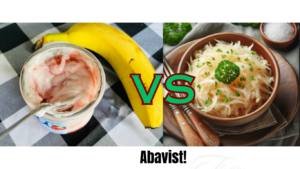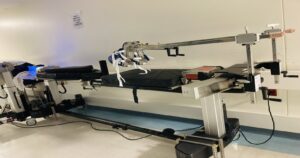VICRYL Suture is a synthetic absorbable violet dyed or undyed suture made of Polyglactin 910 compound, use in hospitals and trauma centers to close surgical wounds and indicated for general soft tissue wound ligation and closure except for cardiovascular and neurological tissues. Absorption Rate 56-70 days.
VICRYL RAPIDE is a suture made from the same polyglactin 910, composed of 90% glycolide and 10% L-lactide copolymer, is a synthetic absorbable suture intended to mimic the performance of collagen (surgical gut) suture with less tissue reaction, Absorption Rate 21- 42 days, intended for use in soft tissue.
All About Vicryl Suture
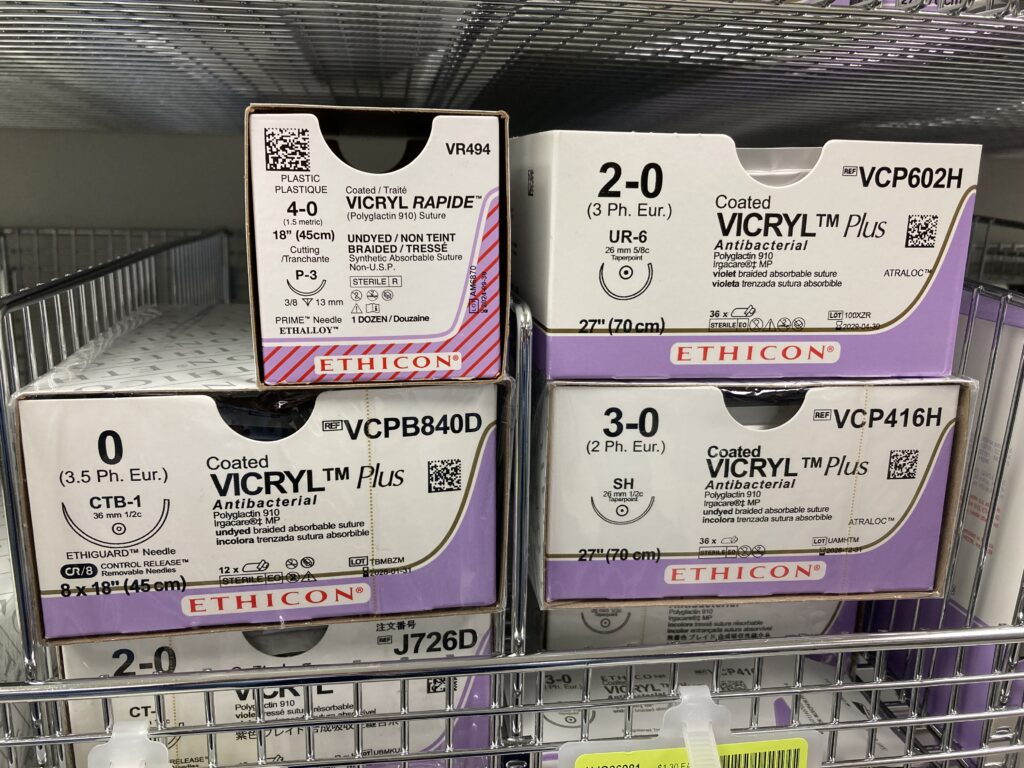

VICRYL Suture is a sterile, synthetic absorbable, surgical suture composed of a copolymer made of 90% Glycolide and 10%l-lactide.The empirical formula of the Copolymer is (C2H2O2)m(C3H4O2)n. VICRYL suture is available as a coated or uncoated suture.
VICRYL sutures are coated with a mixture containing equal parts of Glycolide and lactide copolymer (Polyglactin 370) along with calcium stearate. This combination of Polyglactin 910 copolymer and Polyglactin 370 with calcium stearate has been determined to be nonantigenic and nonpyrogenic, inducing only a minimal tissue reaction during the absorption process.
Differences between VICRYL and VICRYL RAPIDE in the table below.
| VICRYL | VICRYL RAPIDE |
| Absorption Rate: It is absorbed by the body over a period of about 56 to 70 days. | Absorption Rate: It is typically absorbed in about 42 days. |
| Tensile strength : Can hold tissues together longer and more effectively . | Tensile strength : slightly weaker than regular VICRYL due to its faster absorption rate. |
| Used: General soft tissue wound closure and ligation. | Used In procedures where the wound healing process is expected to be quicker. |
| Coated A coating of calcium stearate and polyglactin helps minimize tissue drag, allowing for smoother passage through tissues. | Coated To improve handling characteristics, but the exact composition differ slightly. |
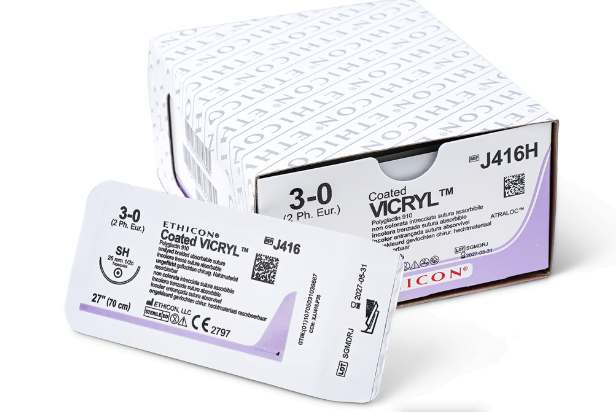
5 Types of Vicryl suture available
1. Coated and Uncoated:
The surface is covered with a blend comprising an equal ratio of glycolide and lactide copolymer (Polyglactin 370) combined with calcium stearate.

Coated vicryl
2. Undyed & Dyed
Beside being available coated and uncoated VICRYL suture is available undyed and dyed with D&C Voilet #2(color Index 60725) this purpose is to enhance visibility in the surgical field.
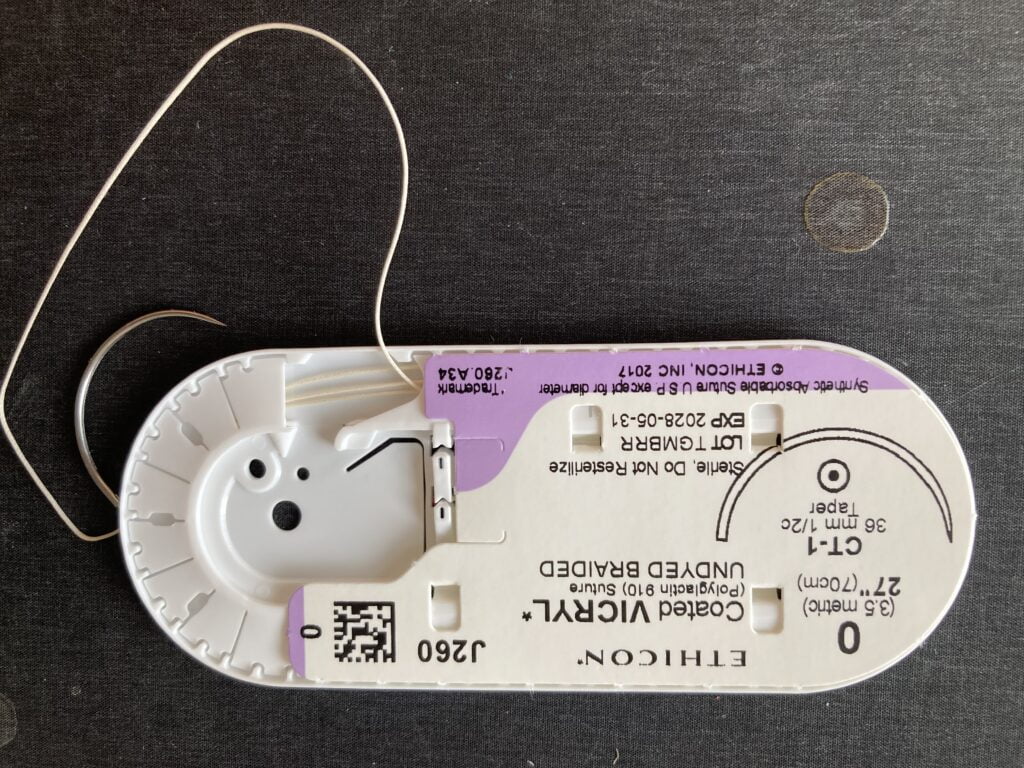
Undyed Coated VICRYL different size

dyed VICRYL suture
3. Gauge size and lengths
Sutures are available in various sizes denoted by gauge, as well as different lengths.
Table below show an example of suture sizes



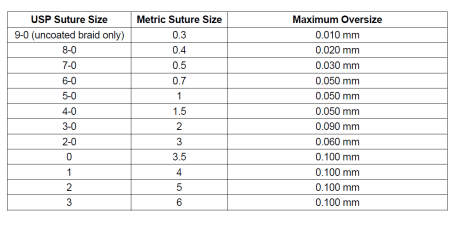
4. Types: VICRYL rapide & VICRYL plus
for example VICRYL rapide and VICRYL plus antibacterial are two different types .
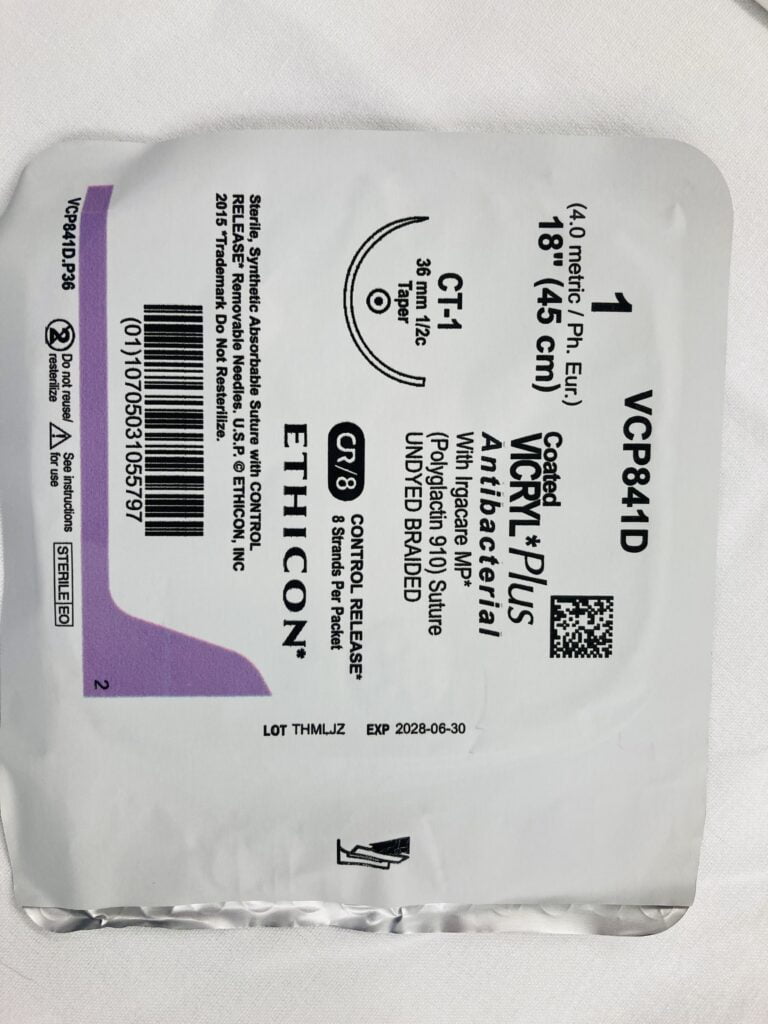
5. Non-needle or attached needle:
VICRYL without needle we operating room staff and surgeon refer to them as ties. Usually use to ligate a blood vessel.
Vicryl without needle in image below

Step-by-step guide for handling Vicryl suture surgical needles safely
1. Grasp the Needle Properly: When handling the surgical needle, grasp it in an area that is one-third (1/3) to one-half (1/2) of the distance from the attachment end to the point. Avoid grasping at the point area to prevent impairment of penetration performance and potential needle fracture. Similarly, avoid grasping at the attachment end to prevent bending or breakage.
2. Avoid Reshaping: Do not attempt to reshape surgical needles as this may cause them to lose strength and be less resistant to bending and breaking.
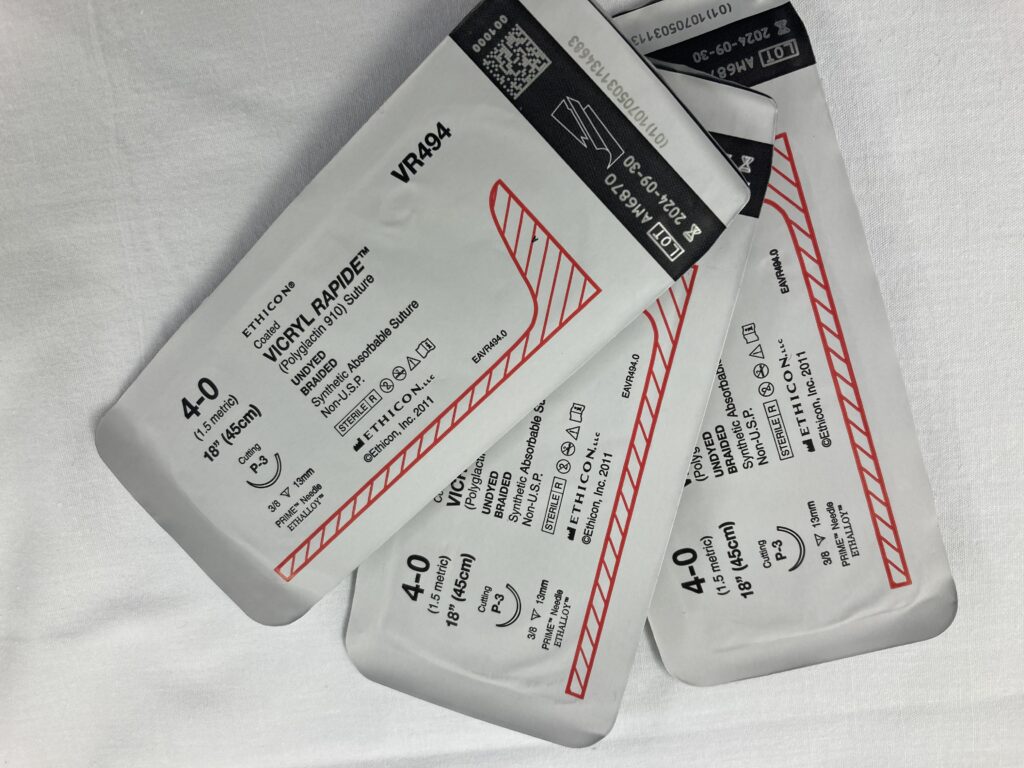
3. Exercise Caution: Use caution when handling surgical needles to prevent inadvertent needle-stick injuries. Broken needles can lead to extended or additional surgeries, or residual foreign bodies in patients.
4. Dispose Properly: After use, discard used needles in designated ‘Sharps’ containers immediately. This helps prevent accidental needle-stick injuries and ensures safe disposal of potentially contaminated needles.
5. Do Not Resterilize or Reuse: Do not attempt to resterilize or reuse surgical needles. Reusing needles or portions of needles can lead to product degradation, which may result in device failure, cross-contamination, and increased risk of infection or transmission of blood-borne pathogens to patients and users.

Warning & Instances where you should never use VICRYL & VICRYL RAPIDE Suture
1. Allergic Reaction: If the patient has a known allergy to any components of Vicryl sutures, such as polyglactin 910, its use should be avoided.
2. Infected Wounds: In cases of infected wounds, Vicryl sutures may not be the best choice, as they can potentially harbor bacteria within the absorbable material, prolonging or exacerbating the infection.
3. Tissue Sensitivity: Some tissues may react poorly to Vicryl sutures, leading to increased inflammation, delayed wound healing, or other complications. In such cases, alternative suture materials should be considered.
4. High Tension Wounds: Vicryl sutures have moderate tensile strength and may not be suitable for wounds under high tension, as they can result in wound dehiscence or poor wound approximation. In such instances, stronger non-absorbable sutures may be preferred.
5. Wound Closure in Areas Prone to Movement: In areas where there is significant movement or tension, such as joints or areas prone to flexion, Vicryl sutures may not provide adequate support and may lead to wound breakdown. Non-absorbable sutures or techniques such as tape closures may be more appropriate.
6. Long-Term Support Requirement: Vicryl sutures are absorbable and lose their tensile strength over time. If long-term wound support is needed, such as in certain orthopedic surgeries, non-absorbable sutures or other fixation methods should be considered.
7. Precise Tissue Apposition Needed: In cases where precise tissue apposition is critical for optimal wound healing, such as in cosmetic procedures or delicate surgeries, the potential for Vicryl sutures to cause tissue reactivity or inflammation may make them less desirable compared to finer, non-absorbable sutures.
8. Vessels less than 2 mm diameter: In cases where anastomosis and microsurgery for vessels is being done and the vessels is smaller than 2mm.
9. Tissue with poor blood supply: Do not use in such areas, as suture extrusion and delayed absorption may occur. Subcuticular sutures should be placed as deeply as possible to minimize the erythema and induration normally associated with the absorption process.
10. Extended exposure of sutures to salt solutions: like those present in the urinary or biliary tracts, can lead to the development of calculi.
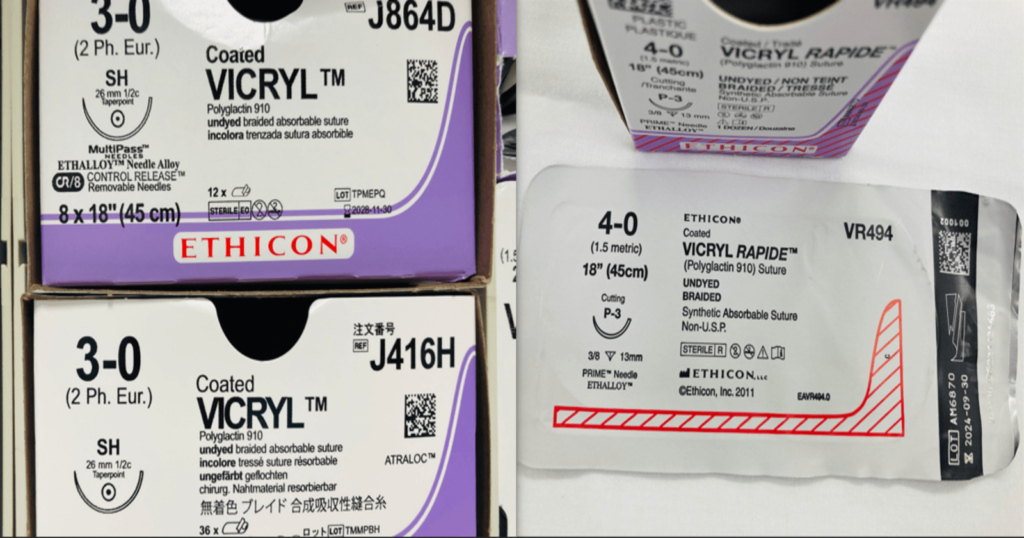
Which types of Patients & conditions Vicryl is not appropriate to be Used on

| Patient Type | Conditions That May Delay Wound Healing |
|---|---|
| Elderly | Malnutrition, debilitation, chronic illnesses |
| Malnourished | Malnutrition, chronic illnesses |
| Debilitated | Chronic illnesses, compromised immune system |
| Patients with Delayed Healing | Diabetes, peripheral vascular disease |
| Immunocompromised Patients | HIV/AIDS, organ transplant recipients |
| Patients on Immunosuppressive Drugs | Chemotherapy, corticosteroid therapy |
| Patients with Chronic Diseases | Cardiovascular diseases, renal failure |
Surgical procedures for which Vicryl and Vicryl RAPIDE sutures are commonly used
| Vicryl Suture | Vicryl RAPIDE Suture |
|---|---|
| General Surgery: Closure of abdominal incisions, fascia, muscle layers | General Surgery: Closure of abdominal incisions, fascia, muscle layers, where rapid absorption is desired |
| Obstetrics and Gynecology: Closure of episiotomies, perineal repair after childbirth | Obstetrics and Gynecology: Closure of episiotomies, perineal repair after childbirth, where rapid absorption is desired |
| Orthopedic Surgery: Closure of subcutaneous tissue, deep dermal layers | Orthopedic Surgery: Closure of subcutaneous tissue, deep dermal layers, where rapid absorption is desired |
| Cardiovascular Surgery: Not typically used | Cardiovascular Surgery: Closure of vascular tissue where rapid absorption is desired |
| Plastic Surgery: Closure of subcutaneous tissue, deep dermal layers | Plastic Surgery: Closure of subcutaneous tissue, deep dermal layers, where rapid absorption is desired |
| Ophthalmic Surgery: Closure of conjunctiva, scleral tissue | Ophthalmic Surgery: Closure of conjunctiva, scleral tissue, where rapid absorption is desired |
Performance /Actions of VICRYL suture
- Absorption: VICRYL is absorbed by the body through hydrolysis, a process where the suture gradually breaks down in tissue fluids. This typically occurs over a period of about 56 to 70 days.
- Tensile Strength: Vicryl suture provides good initial tensile strength, which is important for holding tissues together during the initial healing phase.
- Knot Security: It is known for its excellent knot security, which means that knots tied with VICRYL tend to stay in place without slipping.
- Flexibility: VICRYL is relatively flexible, making it suitable for use in areas where the tissue may undergo movement or stretching.
- Reduced Tissue Reactivity: Compared to some other sutures, Vicryl generally elicits a milder tissue reaction, making it a good choice for delicate or sensitive tissues.
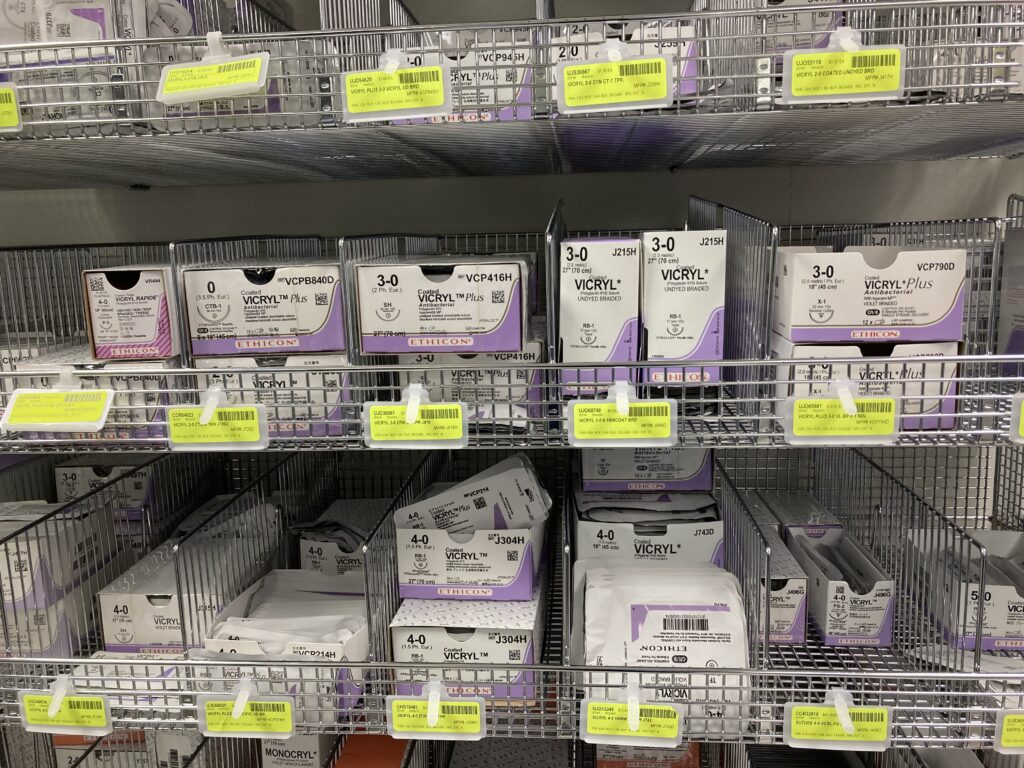
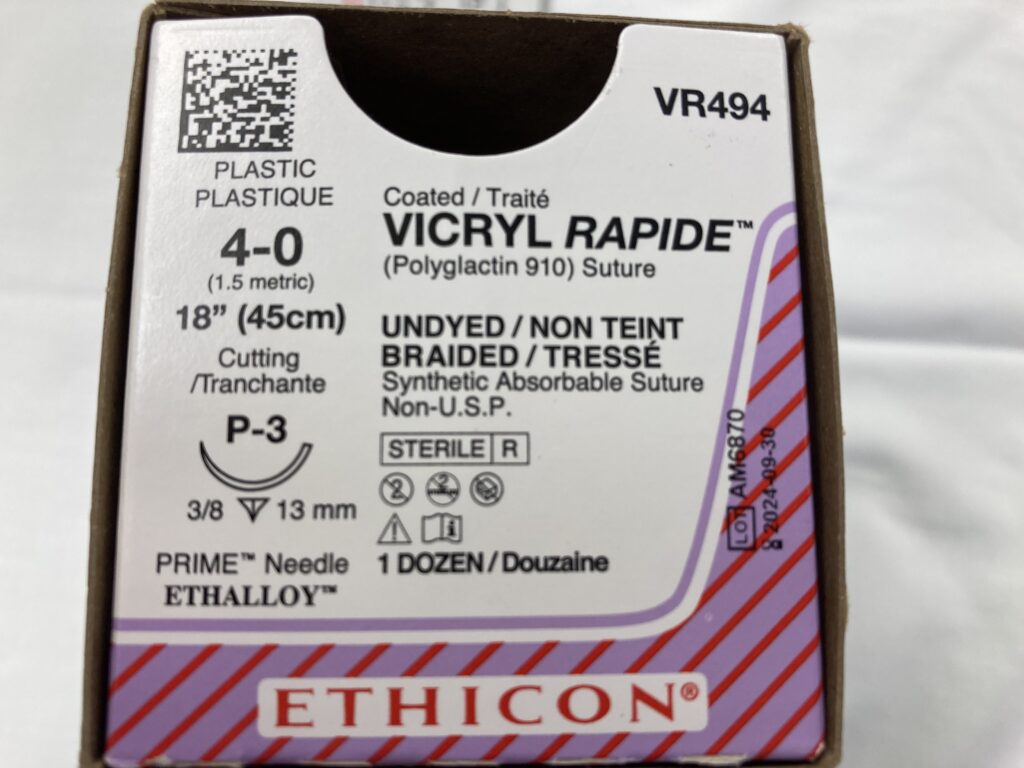
- Minimal Tissue Drag: VICRYL has a smooth surface that reduces friction as the suture is passed through tissues, minimizing trauma.
- Predictable Absorption: Its absorption rate is fairly consistent, which allows for more accurate planning of suture removal or estimation of how long the suture will provide wound support.
- Sterilization: VICRYL sutures are supplied sterile and are intended for single-use to minimize the risk of infection.
- Various Sizes and Needle Types: Like most sutures, VICRYL is available in a range of sizes (gauges) and lengths, as well as with different types of needles (e.g., tapered, cutting, round).
- Versatile Applications: VICRYL is used in a variety of surgical procedures, including gynecology, urology, general surgery, and obstetrics.
- Biocompatibility: It is generally considered biocompatible, meaning it is well-tolerated by the body without causing significant adverse reactions.
It’s important to note that while VICRYL is an excellent choice for many situations, the choice of suture material depends on a variety of factors including the type of tissue being sutured, the location of the wound, and the specific needs of the patient. Always consult a healthcare professional for specific medical advice or recommendations.
VICRYL Suture percentage of strength days after it is implanted
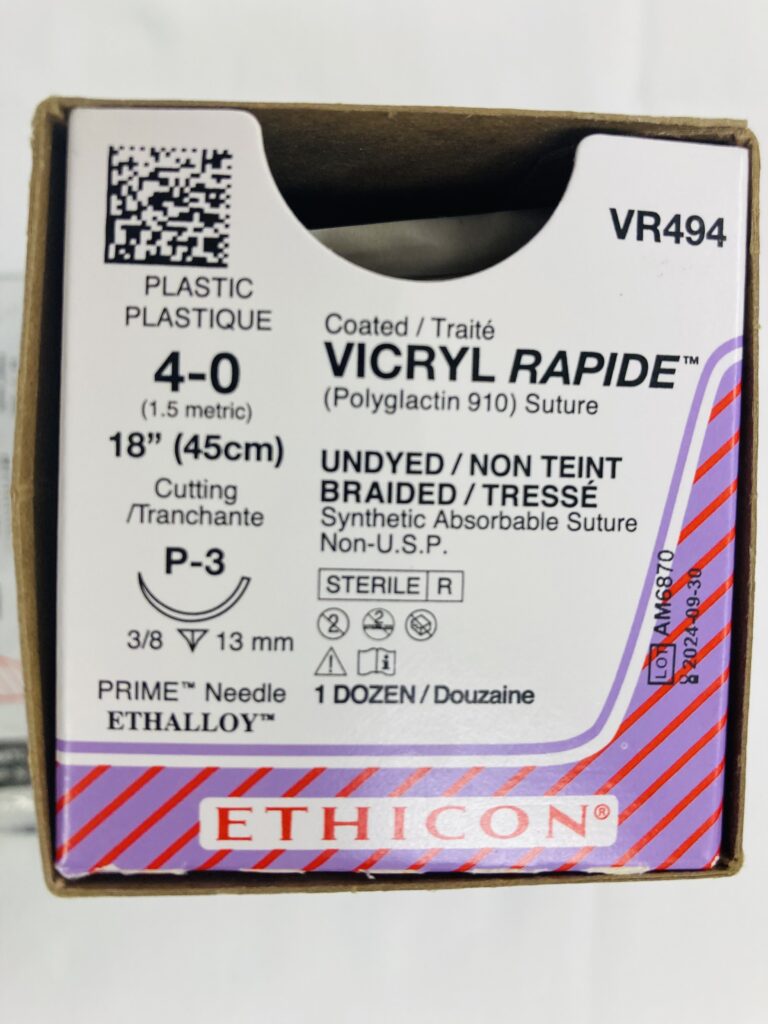

| Days Implantation | Approximate % Original strength Remaining |
| 14 Days | 75 % |
| 21 days USP 6-0(metric 0.7) and lager | 50% |
| 21 days USP 7-0 (metric 0.5) and smaller | 40% |
| 28 days USP 6-0 (metric 0.7) and larger | 25% |
Absorption begins as a loss of tensile strength followed by loss of mass. All of the original tensile strength is lost by 5 weeks post implantation.
Absorption is essentially complete between 56 to 70 days
Disadvantages of Vicryl Suture
| Disadvantage | Explanation |
|---|---|
| Tissue Reaction | Some patients may experience an inflammatory reaction to Vicryl, leading to redness, swelling, or pain. |
| Knot Security | Vicryl knots may be less secure compared to other suture materials, increasing the risk of unraveling. |
| Absorption Rate | Vicryl absorbs relatively quickly, which may not provide sufficient long-term wound support in some cases. |
| Handling Characteristics | Vicryl can be more difficult to handle compared to other sutures, requiring skill and practice for use. |
| Tensile Strength | Vicryl may have lower tensile strength compared to non-absorbable sutures, affecting wound closure integrity. |
| Wound closure | Not a good choice for cutaneous wound exposed to air. It draw moisture from the healing tissue to the skin that allow bacteria and irritants to migrate to the wound. |
What is Vicryl Rapide
VICRYL RAPIDE is a brand name for a type of absorbable surgical suture. It is a product of Ethicon, a subsidiary of Johnson & Johnson, which is a well-known medical equipment company.
Sutures are used by surgeons and medical professionals to stitch together wounds or surgical incisions. What makes VICRYL RAPIDE “rapid” is its characteristic of being absorbed by the body at a faster rate compared to traditional VICRYL sutures. This means that VICRYL RAPIDE typically does not need to be removed manually, as the body will naturally break down and absorb the suture material over time.
VICRYL RAPIDE
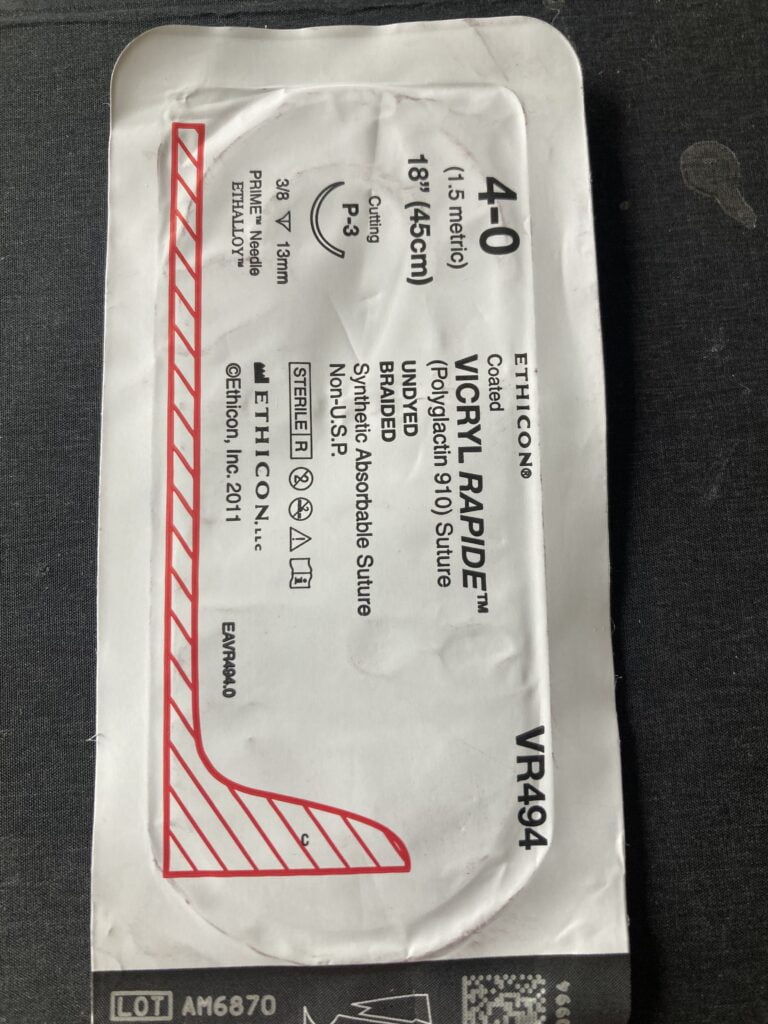
VICRYL RAPIDE marks a significant advancement in absorbable sutures, engineered for expedited absorption and prompt wound recovery. Crafted from the reliable polyglactin 910 material, it seamlessly blends strength with swift breakdown, making it an optimal choice for procedures demanding efficiency.
Due to its absorption profile VICRYL RAPIDE is useful for skin closure, particularly in pediatric surgery, episiotomies, circumcision and closure of oral mucosa.
Per Manufacturer Coated VICRYL RAPIDE suture is not intended for use in ligation ophthalmic, cardiovascular or neurological procedure.
Key Actions of Vicryl RAPIDE
Coated VICRYL RAPIDE suture when use in closure of skin and mucous membranes, typically begins to fall off 7- 10 days post-operatively and can be wiped off subsequently with sterile gauze.
Similarities between VICRYL and VICRYL RAPIDE
- Needle Types:
- Both VICRYL and VICRYL RAPIDE are available with various types of needles (e.g., cutting, taper, etc.) to suit different surgical needs.
- Color:
- Both VICRYL and VICRYL RAPIDE are typically violet or undyed, which helps in their identification during surgery.
- Cost:
- The cost of VICRYL and VICRYL RAPIDE may vary based on factors like location, supplier, and quantity purchased. In general, VICRYL RAPIDE might be slightly more expensive due to its specialized properties.
How to heal stitches Faster
Healing stitches faster involves a combination of good wound care practices, a healthy diet, and overall wellness. Here are some tips to help speed up the healing process:
1. Follow Your Doctor’s Instructions
- Adhere strictly to any wound care instructions provided by your healthcare provider. This may include how to clean the area, when to change dressings, and any signs of infection to watch out for.
2. Keep the Area Clean and Dry
- Gently clean the area around the stitches with soap and water as advised by your doctor.
- Keep the wound dry to prevent infection and to allow the stitches to hold the skin together properly.
3. Avoid Straining the Area
- Refrain from activities that might stretch or strain the area where the stitches are located, as this could delay healing or even cause the stitches to come apart.
4. Eat a Nutritious Diet
- Protein: Helps rebuild tissue. Include lean meats, eggs, dairy, and plant-based proteins like beans and legumes.
- Vitamin C: Essential for collagen production, which helps skin heal. Include citrus fruits, strawberries, bell peppers, and broccoli.
- Zinc: Promotes wound healing. Found in nuts, seeds, and whole grains.
- Hydration: Drink plenty of water to keep your skin hydrated and support overall healing.
5. Use Antibacterial Ointments (If Advised)
- Apply any prescribed or recommended antibacterial ointment to prevent infection and keep the wound moist, which can promote faster healing.
6. Avoid Smoking
- Smoking reduces blood flow and delays healing. If you smoke, consider stopping or reducing your intake while your wound is healing.
7. Manage Pain Properly
- Take any prescribed pain medications or over-the-counter options as directed to manage discomfort, which can help you rest better and heal faster.
8. Monitor for Infection
- Watch for signs of infection, such as redness, increased pain, swelling, warmth, or pus. If you notice any of these, contact your healthcare provider immediately.
9. Get Plenty of Rest
- Allow your body to heal by getting enough sleep and rest. Healing is faster when your body is not under stress.
10. Consider Supplements (If Advised)
- Some people may benefit from supplements like vitamin C, zinc, or collagen, but consult with your doctor before starting any new supplements.
11. Keep the Area Elevated (If Applicable)
- If the stitches are on a limb, keeping it elevated can reduce swelling and promote faster healing.
Signs of an Allergic Reaction to Vicryl Sutures
Redness and Swelling: Unusual redness, swelling, or inflammation at the site of the sutures that doesn’t improve or worsens over time.
Itching or Rash: Persistent itching or the development of a rash around the suture site.
Pain: Increased pain or tenderness that seems excessive compared to normal post-surgical discomfort.
Pus or Discharge: Unusual or excessive pus or other discharge from the wound site.
Delayed Healing: The wound may take longer to heal or show signs of poor healing.
Fever: A low-grade fever can sometimes accompany an allergic reaction.
What to Do if You Suspect an Allergy to vicryl suture
Contact Your Healthcare Provider: If you notice any of the above symptoms, it’s essential to contact your doctor or surgeon immediately.
Treatment: If an allergy is confirmed, treatment may involve removing the sutures and replacing them with a different material, managing symptoms with antihistamines or corticosteroids, and providing appropriate wound care.
Alternative Sutures: Your healthcare provider may choose to use a different type of suture material in the future, such as silk, nylon, or another synthetic material that you are less likely to react to.
If you suspect you have had a previous allergic reaction to sutures, it’s important to inform your healthcare provider before any future surgeries so they can choose an appropriate suture material.
Common questions people ask and answer
1. What do you use VICRYL suture for?
Used in various surgical procedures to close subcutaneous layers of the skin, where the suture can be buried and does not need to be removed later since it will be absorbed also in procedures such as episiotomies or cesarean sections where internal sutures are required.
2. Why is VICRYL RAPIDE suture use?
VICRYL RAPIDE is favored in situations where rapid absorption, minimal tissue reaction, and reduced need for suture removal are priorities, making it an excellent choice for specific surgical applications.
3. Which is best for wound VICRYL RAPIDE suture or VICRYL ?
VICRYL RAPIDE is best for superficial wounds or areas where quick healing is expected and suture removal might be a concern.VICRYL is more appropriate for deeper tissues or situations where extended support is necessary during the healing process.
4. How long dose it take VICRYL RAPIDE to dissolve?
VICRYL RAPIDE is designed to be absorbed by the body quickly, typically within 7-10 days, with complete absorption by 42 days.
5. Can you close skin with VICRYL?
Yes, VICRYL (Polyglactin 910) is commonly used for closing skin, particularly in surgical procedures.
6. Which suture is more resistent to infection,VICRYL or VICRYL RAPIDE?
VICRYL and VICRYL RAPIDE have similar resistance to infection; neither is specifically more resistant than the other. Infection resistance largely depends on proper surgical technique and wound care rather than the specific suture type.
7. Do stitches heal faster covered or uncovered?
Stitches generally heal faster when they are covered. Keeping them covered helps protect the wound from infection, keeps it moist (which promotes healing), and prevents the stitches from being disturbed.
8. Can you be allergic to vicryl suture?
Yes, it is possible to have an allergic reaction to Vicryl sutures, though it is rare. Vicryl is a synthetic absorbable suture material made from a copolymer of glycolide and lactide, and it is generally well-tolerated by most patients. However, some individuals may develop a hypersensitivity or allergic reaction to the material.
Resources
https://www.jnjmedtech.com/en-US/product/vicryl-rapide-polyglactin-910-suture
https://www.accessdata.fda.gov/cdrh_docs/pdf/K944110.pdf
NSG Suture Training for Operating room On the job and my years of working as a scrub nurse and circulating nurse in the Operating room.




